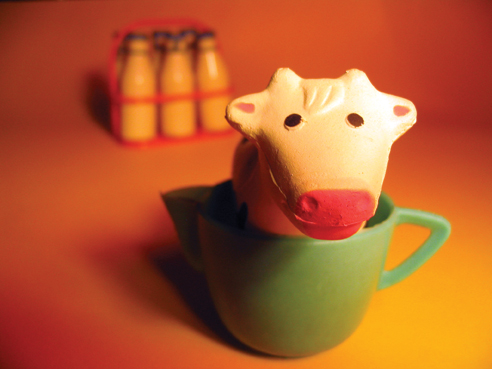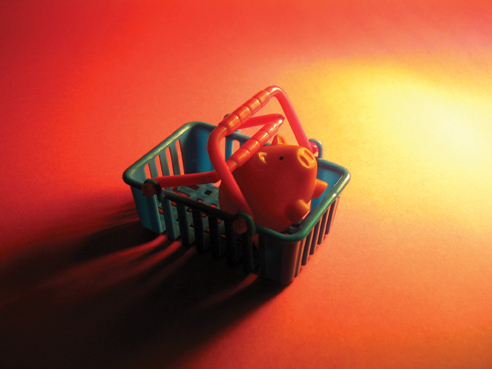September
2006
Featured
Artist: Toys Aren’t Us!
The Satya Interview with
Veronica Ibarra
|
 |
Cow Jug. |
Meet Veronica Ibarra, animal activist and artist
from Spain, whose work creatively conveys messages of animal equality
and veganism. Through
mainly video and photography, Veronica shoots and animates simple objects—toys,
dolls and grocery receipts—evoking anti-speciesist ideas. In
the series “Cooking Set,” she arranges colorful children’s
toys in scenarios like “Cow Jug,” “Chick Plate” and “Lamb
Spoon,” to remind the audience that each animal was someone.
Veronica and fellow vegan artist, Carlos Thomas, are the clever people behind
veganvegan.com, an online store for adorable, handmade anti-speciesist message
gear that support their innovative art endeavors. Be sure to check out their
cute pro-vegan buttons with cows, chickens and pigs exclaiming, “don’t
eat us,” “no me comas” (don’t eat me), and “I feel.”
Taking time out from collecting grocery store receipts for her latest project,
Veronica Ibarra told Sangamithra Iyer about her art and being vegan in Spain.
How did you first get interested in animal issues?
I picked up a few leaflets from an animal rights stall in Madrid, back in 1993.
What I read in them made complete sense to me, so I got actively involved straight
away. I became vegan one year later. One morning, my partner (at that time) and
I realized that we couldn’t carry on eating eggs or cow’s milk. We
knew that being ovo-lacto vegetarian wasn’t going far enough and didn’t
make that much of a difference since we were still using nonhuman animals as
resources and contributing to their exploitation. The only way to respect them
was not to use them at all. The change to veganism wasn’t hard, a piece
of cake really.
Tell us a bit about your artwork and what you are trying to convey.
The work I do addresses issues related to animal equality and speciesism. My
pieces are quite varied, but I work mainly with video and photography. I consider
what I do activism. Art has always been used to question injustice and provoke
social change. I know art (film, sculpture, music, etc.) can be a very powerful
communicator of ideas as it expresses themes in a different manner. People are
more open to unfamiliar ideas when they are expressed in a creative, original
way. Having said that, one has to be honest in making art and can’t be
fake. I’m just expressing my concerns the most interesting way I can and
trying to get a positive reaction from people. I have a long way to go, a lot
of art to do and a lot to learn.
Can you explain “Cooking Set” and your “Animal Eating
Doll?”
“
Cooking Set” is a series of photos that uses colorfully cute aesthetics
to draw the viewer in and get their interest. It talks about two things: the
way we are conditioned since childhood, and the idea we humans have of nonhuman
animals as being mere things to be used. Toys are perfect. They are objects whose
practical function is to represent the real thing for children, a bright playful
fiction mirroring a social reality that regards nonhuman sentient beings the
same way as their plastic counterparts.
“Animal Eating Doll” is an animation based on a sculpture I made
of a doll with an open stomach full of animals. The idea came from the bizarre
thought of while people are walking around, doing their thing, they are digesting
corpses inside their stomachs—corpses they put inside [them], one after
the other, all their lives, non-stop. That’s what the doll does and teaches
her daughter to assimilate—the child is being implanted with speciesist
views and will consider nonhuman individuals as food.
What reactions do you commonly get to your artwork?
Mainly positive, although it’s hard to know what effect a piece has on
each individual viewer, what they get from it, how it changes them, makes them
think or feel. Some works seem more successful than others in terms of effectiveness.
The most positive reaction so far has been with the photos “Cooking Set” and
the animation “The Little Bird Flies Away.”
A good indication of what effect the artwork is having are the thousands of visitors
my website gets a month. A lot of them come from links posted in non animal-related
sites, which is really good. People who wouldn’t normally be interested
in this issue like the artwork. They start thinking about it, discussing it and
recommending the site.
 |
Pig Basket.
|
What are you currently working on?
The animation “Animal Eating Doll” and the installation “Evidencia
A” are my main projects at the moment. “Evidencia A” will consist
of four walls of a room completely covered with thousands of shopping receipts.
Food products that contain animal-derived ingredients will be highlighted with
a fluorescent marker. I’m asking people to contribute by collecting receipts
and mailing them to me. I’m also trying to get some of my pieces shown.
This is an essential part of the process; if people don’t see the work,
it won’t really change anything. I would love to have an exhibition or
screening in the U.S.
Who or what inspires you?
Mmmm…obvious answer: The millions of nonhuman animals suffering and dying
all the time due to speciesism. Also, the strong belief I have of wanting to
dedicate all my life’s efforts to contribute to the end of this injustice,
doing so the best way I can, which in my case is making art about it.
Tell us about the anti-speciesist scene in Spain.
Not that great really. Spain is far behind other European countries. I suppose
the scene is growing. In Spain, most people haven’t given the faintest
thought to how they treat and regard nonhuman animals. I think the movement in
general, not only in Spain, should be more varied and creative, more imaginative
and innovative. Activists seem to be so traditional in the strategies they use
as if they were completely certain those were the most effective ones. Not everyone
responds to a flyer or a demo or wants to sit through a talk. Activism can take
many forms and it’s vital it does; the more ways the message is delivered,
the more people will be reached. What I’m doing doesn’t get much
support or interest from the scene here, and the indie art world is pathetic.
In a few months, we plan on moving to London.
Is it easy to be vegan in Spain? Do you have a favorite vegan restaurant in Madrid?
It’s easy and getting easier. For instance, now you can buy soymilk and
yogurts from any grocers, not just from health food shops or big supermarkets.
The only thing you cannot get is soy cheese—not sure why, not enough demand?
Fresh veg and fruit are good and varied. The best place for eating out in Madrid
is Vegania, a vegan cafe run by my friends Laura and Dani. [They serve] a yummy
Spanish omelet! I wish there were more vegan places—not really, I wish
every place was vegan!
To view Veronica’s art visit www.veronicaibarra.com. For cool vegan
and
anti-speciesist message gear visit www.veganvegan.com.
| |
|
|
© STEALTH TECHNOLOGIES INC. |
|


